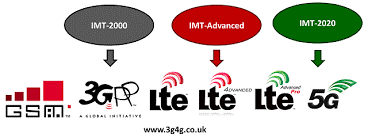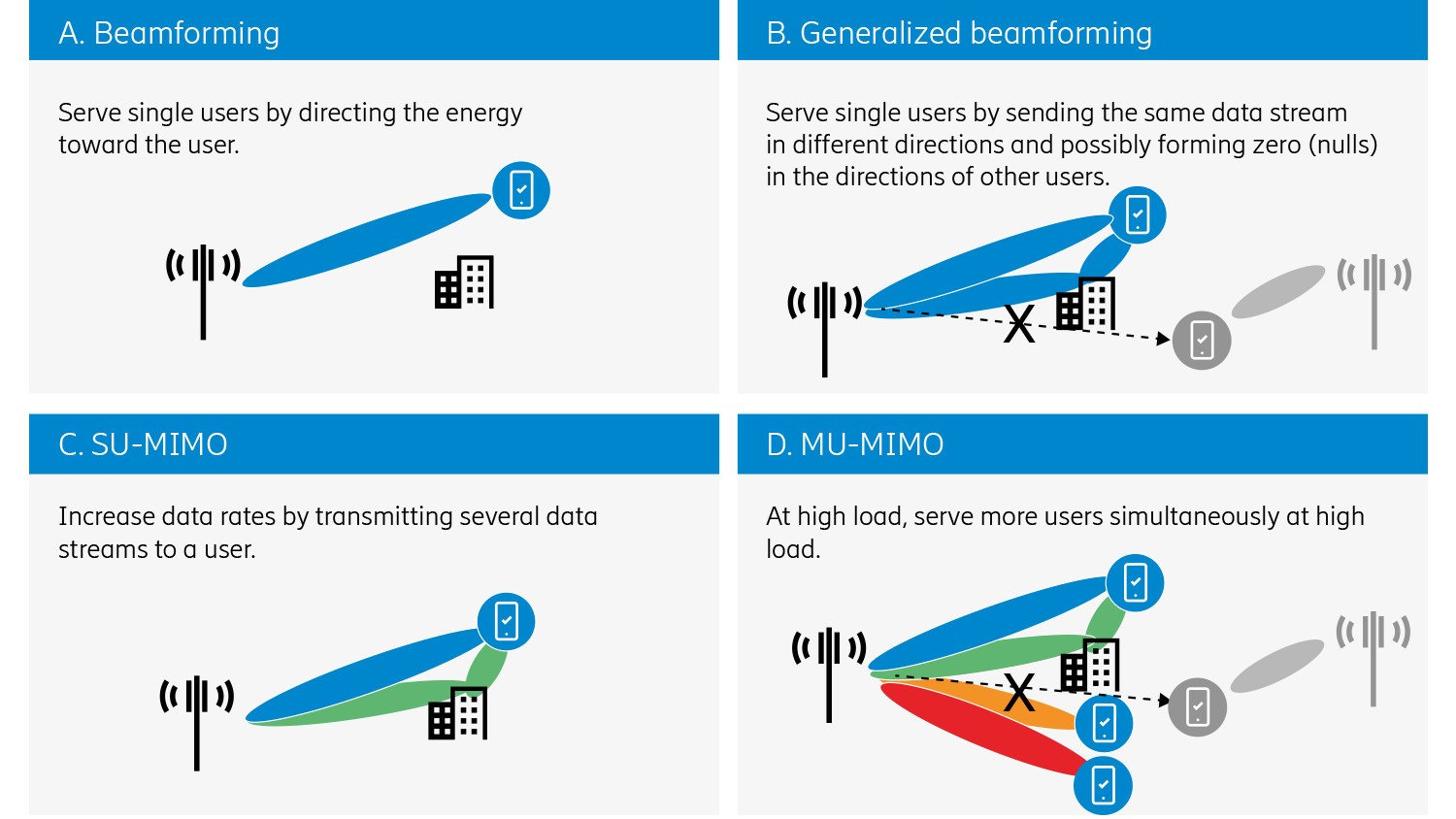5G Technology
Submitted by Shruti Ranjan Maji(Department of BCA, Batch :2017-2020)
University Roll No : 15201217032

Definition:
Advanced antenna systems (AAS) is the general term used to describe antenna systems utilizing techniques aiming at improving performance and spectral efficiency of radiocommunication transceivers taking advantage of antenna array theory and practice.
These techniques include adaptive beamforming, multiple input multiple output (MIMO), and space division multiple access (SDMA) among other ones. These multi-antenna techniques are generally applicable to any frequency band or radio application and can be implemented using passive or active antennas.
In higher frequency bands, such as those around the millimetric wave bands, active advanced antenna systems are the prevalent technology choice.
- Smart antennas
- Adaptive beamforming
- Phased arrays
- Spatial multiplexing and MIMO
- Space Division Multiple Access (SDMA)
- Active and passive antennas
- Antenna Array Theory
Basic concepts of 5G
Multiple antennas can be arranged in space in specific configurations to form a highly directive pattern. These arrangements are referred to as “arrays.” In an array antenna, the fields from the individual elements add constructively in some directions and destructively (cancel) in others thus creating an overall array radiation pattern different from that of the individual elements.
The major advantage of antenna arrays over a single antenna element is their electronic scanning capability; that is, the major lobe can be steered toward any direction by changing the phase of the excitation current at each array element (phased array antennas). Furthermore, by also controlling the magnitude of the excitation current, a large variety of radiation patterns and sidelobe level characteristics can be produced. Adaptive antennas (also called “smart antennas” in mobile communication applications) go a step further than phased arrays and can direct their main lobe (with increased gain) in a desired direction (e.g., a mobile user in a cellular communication system) and nulls in the directions of interference or jammers.
AAS enables state-of-the-art beamforming and MIMO techniques that are powerful tools for improving end-user experience, capacity and coverage. As a result, AAS significantly enhances network performance in both uplink and downlink. Finding the most suitable AAS variants to achieve performance gains and cost efficiency in a specific network deployment requires an understanding of the characteristics of both AAS and of multi-antenna features.
Multi-antenna techniques
Multi-antenna techniques, here referred to as AAS features, include beamforming and MIMO. Such features are already used with conventional systems in today’s LTE networks. Applying AAS features to an AAS radio results in significant performance gains because of the higher degrees of freedom provided by the larger number of radio chains, also referred to as Massive MIMO.
Beamforming
When transmitting, beamforming is the ability to direct radio energy through the radio channel toward a specific receiver, as shown in the top left quadrant of Figure 1. By adjusting the phase and amplitude of the transmitted signals, constructive addition of the corresponding signals at the UE receiver can be achieved, which increases the received signal strength and thus the end-user throughput. Similarly, when receiving, beamforming is the ability to collect the signal energy from a specific transmitter. The beams formed by an AAS are constantly adapted to the surroundings to give high performance in both UL and DL.
Although often very effective, transmitting energy in only one direction does not always provide an optimum solution. In multi-path scenarios, where the radio channel comprises multiple propagation paths from transmitter to receiver through diffraction around corners and reflections against buildings or other objects, it is beneficial to send the same data stream in several different paths (direction and/or polarization) with phases and amplitudes controlled in a way that they add constructively at the receiver [5]. This is referred to as generalized beamforming, as shown in the upper right quadrant of Figure 1. As part of generalized beamforming, it is also possible to reduce interference to other UEs, which is known as null forming. This is achieved by controlling the transmitted signals in a way that they cancel each other out at the interfered UEs.

IBM and Verizon Business Collaborate on 5G
Verizon Business and IBM are working together on 5G and edge computing innovation to help enable the future of “Industry 4.0.” The two companies plan to combine the high speed and (yet to be proven) low latency of Verizon’s 5G and Multi-access Edge Compute (MEC) functionalities, IoT devices and sensors at the edge, and IBM’s expertise in AI, hybrid multi-cloud, edge computing, asset management and connected operations. These will be jointly offered with IBM’s Maximo Monitor with IBM Watson and advanced analytics. The combined products may help clients detect, locate, diagnose and respond to system anomalies, monitor asset health and help predict failures in near real-time. The first solutions to be aimed at helping improve industrial quality, availability and performance.
“Through this collaboration, we plan to build upon our longstanding relationship with Verizon to help industrial enterprises capitalize on joint solutions that are designed to be multi-cloud ready, secured and scalable, from the data center all the way out to the enterprise edge,” IBM’s Bob Lord, SVP of cognitive applications, blockchain and ecosystems, said in a press release from the companies.
“Through this collaboration, we plan to build upon our longstanding relationship with Verizon to help industrial enterprises capitalize on joint solutions that are designed to be multi-cloud ready, secured and scalable, from the data center all the way out to the enterprise edge.”
“This collaboration is all about enabling the future of industry in the Fourth Industrial Revolution,” said Tami Erwin, CEO, Verizon Business. “Combining the high speed and low latency of Verizon’s 5G UWB Network and MEC capabilities with IBM’s expertise in enterprise-grade AI and production automation can provide industrial innovation on a massive scale and can help companies increase automation, minimize waste, lower costs, and offer their own clients a better response time and customer experience.”
For IBM, the announcement underscores its efforts to offer products and services in the edge computing marketplace, an area that’s becoming a key focus for a variety of businesses looking for speedy computing services via nearby or onsite facilities.
And for Verizon, the announcement adds further momentum to its 5G and edge computing ambitions. Company executives have long argued that the combination of 5G and edge computing has a wide range of enterprise applications, and Verizon’s new pairing with IBM could open the doors to more potential customers for such services.
To be clear, Verizon has been working to stamp out a position in the 5G and edge computing sector for years. The company hopes to offer its high-speed, millimeter-wave 5G network across 60 cities by the end of this year, and concurrently it has said it will
launch nationwide 5G on lowband spectrum in that same timeframe. Separately, Verizon
late last year announced it would team up with Amazon to support its AWS edge computing initiative.
But Verizon’s edge computing efforts don’t stop there. The company joined América Móvil, KT, Rogers, Telstra and Vodafone to establish the “5G Future Forum” in January in part to accelerate the development of Multi-access Edge Computing (MEC)-enabled solutions. The group this week announced it will release its first technical specifications in the third quarter.
IMT-2020 Specification
Introduction:
The forthcoming ITU-R recommendation (aka standard) “IMT-2020.SPECS” identifies the terrestrial radio interface technologies of International Mobile Telecommunications-2020 (IMT-2020) and provides the detailed radio interface specifications. This new standard will NOT include IMT 2020 non-radio aspects, such as 5G Core, Signaling, Network Slicing, Network Management/Maintenance, Security/Privacy, Fault Detection/Recovery, Codecs, etc.
This new recommendation was developed by ITU-R WP5D (aka 5D) over the last four or five years. It consists of IMT 2020 (5G) Radio Interface Technologies (RIT) and Sets of Radio Interface Technologies (SRIT).
The final IMT-2020.SPECS is expected to be approved in late November 2020 at the ITU-R SGD meeting.
IMT 2020 RIT/SRIT submission status:
IMT 2020 RIT submissions from 3GPP/China/Korea [1.], TSDSI [2], DECT/ETSI, and Nufront are all being progressed by 5D. The latter two submissions have defined their own version of 5G New Radio (NR) as they do NOT use 3GPP’s 5G NR.
->Hence, there are potentially three different 5G NRs (as the basis for the respective RIT submission) that will be standardized in IMT-2020.SPECS if the DECT/ETSI and Nufront submissions achieve final approval from WP5D.
Note 1. ATIS found the China and Korea IMT 2020 RIT/SRIT submissions to be technically identical to 3GPPs.
Note 2. The TSDSI submission uses 3GPP’s 5GNR but also ADDS functional capability to support Low Mobility Large Cell (LMLC).
5D has approved the 3GPP and TSDSI RIT/SRIT submissions to be progressed to the next step at their recent e-Meeting, but there is still confusion (at least for this author) as to whether the China and Korea submissions (which were stated to be technically identical to 3GPP submissions) will also be progressed. If they are, it will pose a version change nightmare IMHO. 5D posed additional work for both DECT/ETSI and Nufront RITs before they can be progressed to the next step at 5D’s October meeting.
Overview of IMT-2020.SPECS:
The radio interface specifications in IMT-2020.SPECS detail the feature and parameters of IMT-2020. This Recommendation indicates that IMT-2020 enables worldwide compatibility, international roaming, and access to the services under all three usage scenarios, including enhanced mobile broadband (eMBB), massive machine type communications (mMTC) and ultra-reliable and low latency communications (URLLC).
The capabilities of IMT-2020 include:
– very high peak data rate;
– very high and guaranteed user experienced data rate;
– quite low air interface latency;
– quite high mobility while providing satisfactory quality of service;
– enabling massive connection in very high density scenario;
– very high energy efficiency for network and device side;
– greatly enhanced spectral efficiency;
– significantly larger area traffic capacity;
– high spectrum and bandwidth flexibility;
– ultra high reliability and good resilience capability;
– enhanced security and privacy.
These features enable IMT-2020 to address evolving user and industry needs. The capabilities of IMT-2020 systems are being continuously enhanced in line with user and industry trends, and consistent with technology developments.
Related ITU-R references:
– Recommendation ITU-R M.1036 Frequency arrangements for implementation of the terrestrial component of International Mobile Telecommunications (IMT) in the bands identified for IMT in the Radio Regulations
– Recommendation ITU-R M.2083 IMT vision -Framework and overall objectives of the future development of IMT-2020 and beyond
– Recommendation ITU-R M.1822 Framework for services supported by IMT
– Report ITU-R M.2320 Future technology trends of terrestrial IMT systems
– Report ITU-R M.2370 IMT traffic estimates for the years 2020-2030
– Report ITU-R M.2376 Technical feasibility of IMT in bands above 6 GHz
Report ITU-R M.2411 Requirements, evaluation criteria and submission templates for the development of IMT-2020
– Report ITU-R M.2410 Requirements related to technical performance for IMT-2020 radio interface(s)
– Report ITU-R M.2412 Guidelines for evaluation of radio interface technologies for IMT-2020
– Resolution ITU-R 56 Naming for International Mobile Telecommunications
– Resolution ITU-R 65 Principles for the process of development of IMT for 2020 and beyond
– Document IMT-2020/1 IMT-2020 Background 2020
– Document IMT-2020/2(Rev.2) Submission and evaluation process and consensus building for IMT-2020
– Document IMT-2020/20 Process and the use of Global Core Specification (GCS), references, and related certifications in conjunction with Recommendation ITU‑R M.IMT-[2020.SPECS]

